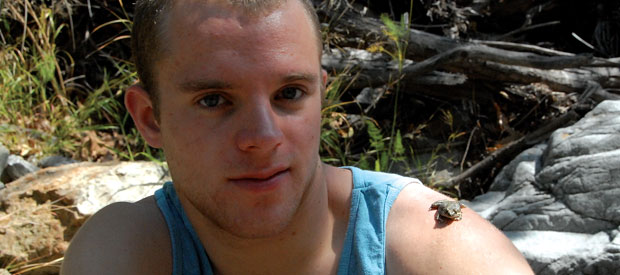Lounging in the Southern California sun, soaking up the rays for as many as 14 hours a day: life sounds pretty nice for the California Tree Frog. But frogs have only a very thin layer of skin, so why—and how—are they able to absorb such high levels of UV rays without accruing skin damage? That question has a group of freshman biology students both fascinated and perplexed, and like a band of biology detectives they have been adventuring through the Santa Monica Mountains on a mission to find the answer.

Until now very little research has been done on the Hyla cadaverina (the California Tree Frog). If Lee Kats, associate provost for research, hadn’t made a throwaway comment during a biology lecture about newts last fall the species might have had a longer wait for its moment in the spotlight. After class, seven students approached him for further information.
“We’re interested in how the frog can sit in the sun for hours and not become a big tumor,” says Tatiana Barrera, who joins fellow students John Buie, Cameron Kruse, Alex Curry, Mason Hankins, Elle Jamison, and Avery Powell in the investigation. “We still don’t know if the sun does it good, or if it just chooses to sit out there.”
The students’ work is done for the love of the research; they receive no class credit and must juggle their busy schedules to meet with Kats and second faculty guide, biology professor Thomas Vandergon, at least once a week.
With virtually no species-specific research available, they started their quest by asking the fundamental question: Is it in fact true that the Hyla cadaverina sits in the sun for long periods of time? “We’ve done a lot of preliminary research to prove that it really does sit out in the sunlight,” says Powell. “There’s no other research; everything out there is about other species.”
“That’s what’s so exciting though,” Kruse interjects. “Because nothing has been done on them before, everything we do is new. These frogs are so abnormal, there must be something different about them.” Curry notes, “What we’ve taken so far has seemed to fall under our hypothesis that they do sit where the UV is highest, with random exceptions, of course.”
The student sleuths spent hours testing at two areas indentified as the frog’s home turf–a stream in Arroyo Sequit Park in the western Santa Monica Mountains, and Trancas Canyon near Malibu–to conclude that the frogs do indeed while away the hours in areas of high UV and high temperatures. The minimum temperature for spotting them seems to be 65 degrees. The sun shines often in Southern California so the exposed frogs are readily accessible—a great benefit for the students as they venture out in groups of three or four to find the frogs and record their data.
But shouldn’t their exposure also be an open invitation for snakes and hawks to enjoy a mid-afternoon snack? “That’s a good point,” agrees Kats. “Why are they not sitting ducks while out in the sun? There’s no evidence that they’re toxic to any would-be predators. We assume at this point that it’s because they’re so hard to spot.”
The frogs seem to make up for their open vulnerability by blending in with the rocks on which they sit, since they’re small, bumpy, and gray or brown in color. In addition to being somewhat hard to see with the naked eye, a second challenge is that they bear a striking resemblance to their close relative, the Hyla regilla, which is identifiable by the black line across its face.
“We can usually find the right one because the California Tree Frog will sit out in the sun, and the other one usually hides,” says Powell. “But we’ve mistaken the two frogs before,” Curry adds.
“Right, we were collecting data around a regilla for hours one day and wondering why the UV was a lot lower around this frog,” Powell explains. “We got frustrated, thinking it was ruining our hypothesis! Until finally one of us said, ‘I don’t think that’s the right frog.’”
Kats observes that the case of mistaken identity was a great experiment in itself, as the doppelganger’s behavior supported their hypothesis by not sitting out in areas of high UV. “I wouldn’t have even thought to collect that data,” he says, complimenting his mentees.
The next step is to test if blocking the UV rays—though not the sunshine—will cause the frogs to move. Ultimately, though, the goal is to discover the reason why UV is so important to this species of frog. Around the world, frogs have been in decline, killed off by a fungus that doesn’t seem to affect the Hyla cadaverina. The reasons why could prove revolutionary for worldwide amphibian research, but for now the group is taking it one step at a time.
“This is one of the best examples of learning as a biologist,” says Kats. “I can lecture all day long and it’s not the same as hammering out experiments and trying to find the frog. It’s been very fun for myself and Dr. Vandergon.”
And while they put the clues together to solve the California Tree Frog puzzle, the students and their mentors bond over cutting-edge, grassroots research, Kruse’s fear of snakes, and numerous run-ins with poison oak. Says Kats, “We have fun, they have fun… Maybe too much fun!”
Whoever said biology couldn’t be an adventure?
Visit magazine.pepperdine.edu/frogs to learn more about undergraduate research at Pepperdine and meet the Tooma family, one of its most ardent supporters.
